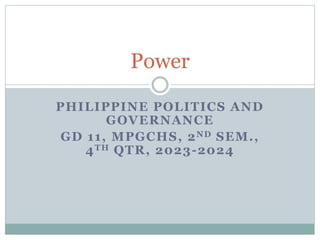
Power.-PPGJ-gd-11J-2nd-sem.J-2023-2024.pptx
- 1. PHILIPPINE POLITICS AND GOVERNANCE GD 11, MPGCHS, 2ND SEM., 4TH QTR, 2023-2024 Power
- 2. Objectives: At the end of the lesson, you should be able to: 1. Define power 2. Recognize the nature, dimensions, types and consequences of power 3. Analyze the nature, dimensions, types and consequences of power 4. Assess how power is exercised in different situations
- 3. Exercises: Is there exercise of power? 1. Your father sent you to buy a galloon of water. 2. Maria tries to escape the building on fire by breaking the glass window. 3. A teacher ask 4 students to return the globe they used in class. 4. Protestors on the streets forced the police to direct traffic into an alternate route. 5. The president made sure that his constituents were happy by giving them cash gifts this year. 6. The stage director kick out the lead actor after 100 retake.
- 4. What is power? a. Definitons: 1. The ability to influence the behavior of others or having ‘power over’ people and the ability to punish or reward. 2. The ability of one person or institution to make another to do something that he/she would not do on his own.
- 5. b. Faces or dimensions of power How power is exercised in our society. 01. Power as decision-making 02. Power as agenda setting 03. Power as thought control 1. Power as Decision-making - conscious actions that in some way influence the content of decisions. * Who’s decisions are followed? - the most powerful actors in the community are those whose opinions are considered and upheld in decision-making.
- 6. Faces/dimensions of power: Power as decision- making * The powerful are able to get what they want and make others behave the way they wanted them to behave. * Decisions can be influenced in a variety of ways: 1. Use of force or intimidation(the stick) 2. Productive exchanges involving mutual gain(the deal) 3. Creation of obligations, loyalty and commitment(the kiss)
- 7. Dimensions/faces of power: Power as agenda setting - ability to prevent decisions being made by setting the agenda or topics to be made * in effect, this is ‘non-decision-making’ - this involves the ability to set or control the political agenda so that issues or proposals are prevented(or excluded) from being brought out in the first place to your advantage.
- 8. Dimensions/faces of power: Power as thought control - ability to influence another by shaping what one thinks, needs, or wants. * How is this done? 1. use of propaganda 2. Ideological indoctrination 3. Psychological control
- 9. Types of Power Power types(French and Raven, 1959): a. Reward power - The target person complies to obtain rewards he/she believes are controlled by the agent. b. Coercive power – The target person complies to avoid punishments he/she believes are controlled by the agent. c. Legitimate power – The target person complies bec. he/she believes that the agent has the right to make the request and that the target person has the obligation to comply.
- 10. Types of Power d. Expert power – The target person complies bec he/she believes that the agent has special knowledge about the best way to do something. e. Referent power – The target person complies bec he/she admires or identifies with the agent and wants to gain the agent’s approval.
- 11. Consequences of Power 3 consequences of power(Yukl, 1989) a. Compliance – readiness or act of agreeing to something * What may create compliance 1. Legitimate or position power - compliance to an order may occur if it is perceived to be within the leader’s scope of authority. 2. Reward power - likely to happen if reward is something valued by the target person.
- 12. Consequences of Power b. Commitment – a state of being dedicated to a cause activity, program, etc. - more desirable outcome because of the trust and emotional pledge that it causes. * Loyalty and sense of devotion is observed. * Likely consequence when Referent and Expert power are used c. Resistance – refuse or oppose *Likely outcome if coercive power is used in a hostile or manipulative way(Yukl, 1989) * Coercion is best used in preventing harmful behavior like illegal or violent activities.